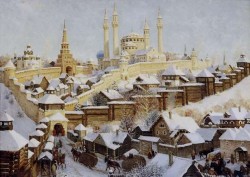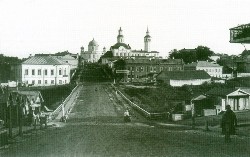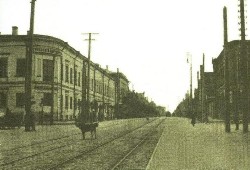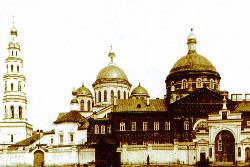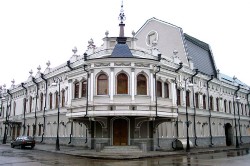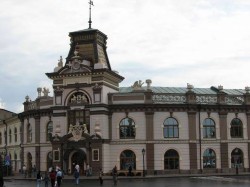Big cities never appear suddenly, they grow from small settlements.
The area occupied by the place where Kazan is now, attracted the people in the Middle Volga nearly 100 000 years ago after the Ice Age.
The ancient settlement grew on a place where the Kazanka river flows into the Volga.
A lot of Volga Bulgarian people came to these lands in the Bronze Age.
Men were hunters, women took up primitive farming.
In the Bronze Age several settlements appeared on the territory of the present Kazan. 20 000 years ago Finno-Ugric tribes came from Ural and Siberia
They built a settlement on the Kremlin hill, which grew into the modern city o Kazan. Trading and industrious people lived here. Volga Bulgaria was strong and developing fast. The Bulgars minted their own coins of silver.
This state was an important centre of international trade. Bulgar leather goods of high quality, furs, wool were bought not only in the countries of the East, but also in Lithuania, Poland, Italy. In Central Asia and Iran the best leather is called Bulgar since that time
Towns with beautiful palaces and schools, stone and wooden houses, buildings with central heating and other structures were built at that time. Science, philosophy and literature were also developing.
The culture of the Golden Horde influenced the Tatar people greatly. Lots of villages and towns were burnt during the Mongolian invasion in 1236-1240. Soon they were reconstructed. From the second half of the 13th century hard times began for the city. The country became a part of the territory of the Golden Horde.
Some Bulgars moved to another place. It became the centre of a new independent state. Its development began in the second half of the 14th century. It attracted migrants and merchants.
In 1399, Moscow prince Juri, a son of Dmitry Donskoy, destroyed the town completely By the middle of the 15th century the town had been rebuilt. At that time the Kazan khanate was formed on the banks of the Volga River.
It took the role of the former state of Volga Bulgaria with Kazan as its cultural and trade centre.
In its Golden Age Kazan occupied the territory of 70 hectares. There lived about 15 000 people. Kazan grew quickly, and by the late 15th century, it had become the largest town in the Middle Volga.
In the early 16th century the peaceful life of the town ended.
The life of the Kazan Province was one of struggle between various parties. At the end of the 5th century the Moscow Principality became stronger and began active interference in the political life of the Kazan khanate. Kazan won the battle.
In summer and autumn 1552 Ivan the Terrible, the Russian tsar, attacked Kazan. A 150-
thousand army, led by Ivan the Terrible, took Kazan by storm. It became part of Muscovy. Tsar Ivan asked his people to rebuild the town. The life became more peaceful and Kazan
became a trading and administrative centre of the region. In the middle of the 17th century
Kazan was one of the biggest cities in Russia. Its population was 20 000 people.
The reforms of Peter I opened a new period in the history of Russia and Kazan as well.
His reforms effected the life of ther city greatly. Since 1708 it became the centre of one of the biggest provinces. The reforms in the economic and cultural life began.
In July 1774 clouds of dust appeared from the side of Arskoye Pole. They were parts of
Emeliyan Pugachev's army. In the early morning of the 12th of July, 1774, Pugachev's people
divided into 4 groups and attacked the city. They couldn't take the Kremlin, and then they
started to rob and kill. 2200 buildings were burnt. The last fight was on the 15th of July,
1774, near the village Czariczino. The fight lasted the whole day. Pugachev's army lost 2000
people and went away along Kokshayskaya street to the forest. They crossed to the right
bank of the Volga.Kazan won the battle. So in summer, 1774, ended Pugachev's invasion of Kazan.
In the early 19th century there were many big and small enterprises and handicraft shops. Kazan merchants sent their goods to Russian cities, China, Bukhara, Khiva and Persia as well. Merchants and industrialists turned Kazan into an economic centre.
In 1874 the water supply system began to work. The streets were lit with gas. There was electricity in some houses.
In 1875 the first line of the horse railway was built. In 1899 the first electric train appeared in the streets. There were more than 5 000 houses and 237 streets in Kazan. The population grew greatly.
At the end of the 19th century Kazan was one of the first five Russian cities in industry and business. In the new century there were 300 different enterprises in Kazan.
In the 20th century Kazan became important as an administrative and cultural centre of the country.
At the beginning of the 20th century Kazan became the capital of the Tatar Soviet Republic. The life of the city at that time was difficult. The problems of food and medicine
were very important. In 1919-1920 an epidemic of typhus began. Many people died, thousands of people migrated from the city.
Later the enterprises were reconstructed, a new bridge across the Kazanka river was built. The city radio started working. New clinics were opened. New parks and workers' clubs were organised. There were great changes in the cultural life. Famous Tatar composers, painters, architects began their work. With the beginning of the Second World War life in the city changed. Kazan gave a great support to the Soviet Army. In 1941 more than 32 000 people went to make fortifications on the right banks of the Volga and the Kama.
In the 1950s new public buildings appeared: the Opera and Ballet Theatre, lots of houses of culture and cinemas: Druzhba, Pobeda, Mir, Zvezda. In 1959 the Kazan television centre began its work.
At the end of the 20th century together with the whole country Kazan experienced a rapid change. By the mid-1980s Kazan had become a major industrial centre. The city produced a range of goods. The population of the republic increased greatly. In 2002 there lived 3 782 600 people.The present life of the city is filled with creativity and new hopes for the future.
In the 21st century great investment projects are to be introduced in Kazan. Life in the city is changing too. Statistics from the 2006 Census showed that 3 768 500 people lived in Tatarstan. The city is becoming more comfortable, cleaner and nicer. The celebrations of the 1000th anniversary in 2005 became a symbol of the rich history of the city.
